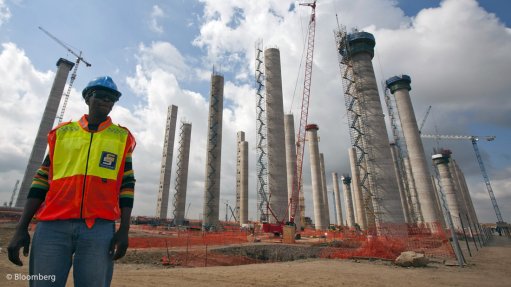
Medupi
Photo by: Bloomberg
To blame the weak rand on only the weak manufacturing and mining figures is incorrect. The weaker rand, similar to a weaker euro and other currencies worldwide, can mainly be attributed to the strengthening of the dollar.
Indications are that interest rates will be lowered in the Eurozone while increases in the USA might be pushed forward, making it more lucrative to invest in America. This naturally results in capital flowing to the USA, away from the Eurozone andother countries, having a negative impact on the respective currencies.
The weak production figures in mining and manufacturing were expected and as such did not have a major impact on the rand exchange rate.
Two main drivers are to blame for these poor figures. Firstly, the protracted strike action in both the mining and metal and engineering sectors resulted in a massive reduction inexport figures. Secondly, the effect of a lack of capacity in respect of electricity provision by Eskom is a major cause for the poor production figures. If sufficient capacity in respect of electricity provision existed, other goods could have been exported.
The emasculating effect of the less than favourable capacity of Eskom on our economy cannot be underestimated. The fact that the building cost of Medupi and Kusile will eventually be close to three times the original amount budgeted while the completion date had to be postponed on several occasions, makes this one of the worst project failures in the world.
The original cost was set at R52bn while the latest amount quoted now stands at R131bn. Quoting from an article in Techcentral, “…the original date for production by Medupi’s first unit was January 2010; it is now January 2015. Due to all the delay, Eskom will lose more than four years of revenue from a 4 764MW station, which amounts to about 86bn kWhs of energy. At a conservative figure of 50c/kWh, this is a loss of R43bn in revenue that could have been used to offset electricity price increases.
The cost of unserved energy to the economy (the losses suffered in the economy due to unavailability ofenergy) is R75/kWh. Given that 86bn kWhs were unserved, we can estimate thetotal cost to the economy was R6,45 trillion. This is an amount of money that the majority of people simply cannot comprehend. It is equivalent to 129m RDP-sized houses, which would provide more than two for every single South African”
Because of the dire inhibiting consequences of the two the projects, both in terms of costs andcompletion dates on our national economy, Uasa believes government should launch a detailed investigation into the causes of both the spiralling costs as well as the causes of delays.
Issued by UASA